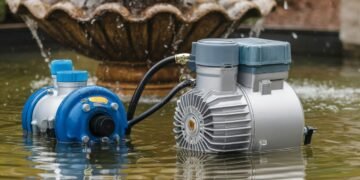Lush, green lawns don’t happen by accident. They require proper watering to ensure healthy growth and vibrant foliage. One of the key tools in achieving efficient irrigation is the lawn sprinkler system. But have you ever wondered how these devices deliver water in such an effective and efficient manner?
In this article, we’ll delve into the science behind the spray and explore the mechanisms that allow lawn sprinklers to distribute water evenly, conserving this precious resource while promoting optimal lawn health.
Types of Lawn Sprinkler Systems
Before delving into the science behind the spray, it’s important to understand the different types of lawn sprinkler systems available. There are several popular options, including oscillating sprinklers, impact sprinklers, rotary sprinklers, and pop-up spray sprinklers.
Each type operates on distinct principles and delivers water in specific ways. Understanding these variations is essential in comprehending the underlying science behind their efficiency.
Let’s explore each type in more detail.
1. Oscillating Sprinklers
Oscillating sprinklers are commonly recognized by their horizontal bar with multiple nozzles that move back and forth, creating a fan-shaped spray pattern. These sprinklers are versatile and suitable for medium-sized areas. Water is distributed in a gentle, sweeping motion, providing even coverage across the lawn.
2. Impact Sprinklers
Impact sprinklers feature a rotating head that releases bursts of water through a nozzle by the force of water striking against a deflector. The impact creates a distinct “tik-tik-tik” sound as the sprinkler rotates. This type of sprinkler is known for its durability and ability to cover large areas. It delivers water in a circular pattern with varying distances, ensuring widespread coverage.
3. Rotary Sprinklers
Rotary sprinklers utilize rotating heads driven by gears or water-driven turbines. As the head rotates, water is ejected in a specific pattern, which can be full circle, part circle, or adjustable. Rotary sprinklers are versatile and suitable for various lawn sizes and shapes. They provide consistent coverage and are often used in conjunction with multiple sprinkler heads to achieve comprehensive watering.
4. Pop-up Spray Sprinklers
Pop-up spray sprinklers are discreetly installed below ground level and “pop up” when activated. These sprinklers distribute water through a fixed or adjustable spray nozzle, creating a spray pattern that can be full circle, part circle, or rectangular. Pop-up spray sprinklers are commonly used in smaller or irregularly shaped areas and are often found in residential landscapes.
Water Pressure and Flow
The effectiveness of a sprinkler system depends on the hydraulic principles governing water pressure and flow. Water pressure, supplied by a connected water source or pump, determines the force at which water is expelled from the sprinkler head. It influences the spray radius and height of the water stream. Meanwhile, water flow rate determines the volume of water delivered over a given time.
Optimizing Water Distribution
The design of the sprinkler nozzle plays a critical role in optimizing water distribution. Nozzles are engineered to create specific spray patterns, such as full circle, half circle, or quarter circle. They incorporate a combination of orifices, screens, and other features to regulate water flow, pressure, and trajectory. By adjusting these parameters, nozzle design allows for precise control over water distribution, ensuring even coverage and reducing overspray.
Achieving Uniform Coverage
Rotary sprinklers and oscillating sprinklers rely on specific rotation mechanisms to achieve uniform water coverage. Rotary sprinklers utilize gears or water-driven turbines to rotate the sprinkler head, distributing water in a circular or arc pattern.
Oscillating sprinklers employ a mechanical mechanism that moves the sprinkler bar back and forth, creating a sweeping spray pattern across the lawn. These rotation mechanisms ensure that water is evenly distributed, minimizing dry spots and avoiding excessive saturation.
Smart Sprinkler Technology
The advancements in smart sprinkler technology have further enhanced water efficiency. Smart sprinkler systems incorporate sensors, weather data, and automation to optimize watering schedules based on real-time conditions. Soil moisture sensors, for example, measure the moisture content in the soil, enabling the system to adjust watering frequency and duration accordingly.
Weather sensors monitor temperature, humidity, and rainfall, allowing the system to conserve water by adapting to changing weather patterns. By integrating these technologies, smart sprinkler systems maximize efficiency by delivering the right amount of water at the right time, preventing overwatering and unnecessary water wastage.
Maintenance and Fine-Tuning
To maintain the efficiency of a lawn sprinkler system, regular maintenance and fine-tuning are necessary. This includes checking and cleaning the sprinkler heads, adjusting the direction and range of the spray, and ensuring that there are no leaks or clogs in the system.
Additionally, monitoring water pressure and flow rate helps identify any issues that may affect the system’s performance. By staying proactive with maintenance, homeowners can ensure that their sprinkler system continues to deliver water efficiently and effectively.
Parting Words
Understanding the science behind the spray reveals the intricate mechanisms and principles at work in lawn sprinkler systems. From hydraulic principles governing water pressure and flow to the design of nozzles and rotation mechanisms, each element contributes to the efficient distribution of water.
With the advent of smart sprinkler technology and ongoing maintenance, these systems have become even more effective in promoting optimal lawn health while conserving water resources. By harnessing the science behind the spray, homeowners can achieve efficient irrigation, resulting in vibrant and healthy lawns for years to come.
Recommended Posts:















